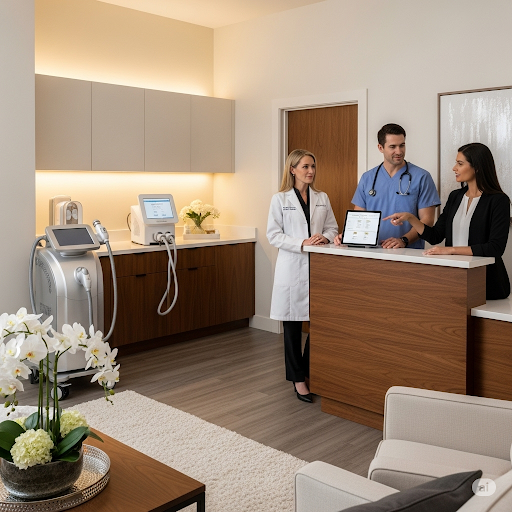In the burgeoning world of aesthetic medicine, medical spas – often called “med spas” – have carved out a unique and increasingly popular niche. They blend the relaxing ambiance of a traditional spa with the advanced medical treatments performed by licensed professionals. If you’re considering opening, operating, or even just curious about the intricate workings of these establishments, understanding the backbone of their operations – especially the role of a medical spa management company – is crucial.
This guide aims to demystify the landscape of med spa management, offering clear, practical, and scientifically grounded insights without the jargon or sales pitches. We’ll explore everything from essential operational structures to what makes a med spa thrive, all to help you navigate this exciting industry with confidence.
What Exactly is a Medical Spa? Understanding the Core
Before we dive into management, let’s solidify our understanding of a medical spa. At its heart, a medical spa is a facility that offers non-surgical aesthetic medical procedures in a spa-like setting. Unlike traditional day spas that focus on relaxation and superficial beauty treatments (like basic facials or massages), med spas provide services that often involve medical devices, injectables, and procedures that require a deeper understanding of human anatomy, physiology, and pathology.
Common treatments found in a medical spa include:
- Botulinum Toxin Injections (e.g., Botox, Dysport, Xeomin): Used to temporarily relax muscles and reduce the appearance of wrinkles.
- Dermal Fillers: Injected to add volume, smooth lines, and enhance facial contours.
- Laser Treatments: For hair removal, skin resurfacing, pigment correction, and vascular lesions.
- Chemical Peels: To exfoliate the skin and improve its texture and appearance.
- Microneedling: To stimulate collagen production and improve skin texture.
- Body Contouring Devices: Non-invasive technologies to reduce fat or tighten skin.
The critical distinction is the medical oversight. Because these procedures carry potential risks and require medical expertise, a licensed physician or other qualified medical professional must oversee the facility’s operations and ensure patient safety and appropriate treatment protocols. This brings us to a foundational concept in med spa management: the Medical Spa Organization (MSO).
What is an MSO for a Medspa? Deconstructing the Management Model
The acronym “MSO” stands for Management Services Organization. In the context of a medical spa, an MSO is a separate entity that provides comprehensive administrative and business support services to the medical practice within the med spa. This structure is often employed to navigate complex regulatory landscapes, particularly those related to the “corporate practice of medicine” doctrine.
The Corporate Practice of Medicine (CPOM) is a legal doctrine in many U.S. states (and similar regulations exist in other countries) that prohibits corporations or non-licensed individuals from employing physicians or owning medical practices. The intent is to prevent business interests from interfering with medical judgment and patient care.
Here’s how an MSO typically works for a med spa:
- The Medical Practice: This is the entity legally authorized to provide medical services. It is owned by a licensed physician or, in some cases, other licensed medical professionals, depending on state regulations. This entity directly employs the medical professionals (nurses, physician assistants, aestheticians performing medical treatments) and handles the direct patient care.
- The MSO: This is the business entity that handles all the non-clinical aspects of the med spa. Its services typically include:
- Marketing and Branding: Developing strategies, managing advertising, and building the med spa’s public image.
- Human Resources: Recruitment, hiring, payroll, benefits administration for non-clinical staff, and support for clinical staff.
- Financial Management: Billing, accounting, revenue cycle management, budgeting, and financial reporting.
- Facilities Management: Lease negotiations, maintenance, and ensuring a professional environment.
- Information Technology (IT): Managing software, electronic health records (EHR), and cybersecurity.
- Regulatory Compliance: Assisting the medical practice in adhering to healthcare laws, patient privacy regulations (like HIPAA), and licensing requirements.
- Purchasing: Sourcing equipment, supplies, and negotiating vendor contracts.
Why is an MSO used?
- Compliance: It helps adhere to the corporate practice of medicine laws, allowing non-physicians to invest in and manage the business side without directly owning the medical practice itself.
- Efficiency: It centralizes administrative functions, allowing medical professionals to focus on patient care.
- Scalability: It provides a framework for growth, as the MSO can support multiple medical practices or locations.
- Expertise: It brings specialized business and operational knowledge that medical professionals might not possess.
Who can own an MSO?
Unlike the medical practice, which must be owned by licensed medical professionals (typically physicians), an MSO can generally be owned by non-physicians or corporate entities. This allows entrepreneurs, investors, or business professionals to participate in the lucrative medical aesthetics industry by managing the business aspects without violating healthcare regulations. However, it’s crucial to understand that the MSO cannot dictate medical decisions or interfere with the clinical judgment of the licensed medical professionals. The relationship is typically governed by a comprehensive management services agreement (MSA) that clearly defines the roles, responsibilities, and financial arrangements between the MSO and the medical practice.
The Financial Landscape: What to Expect in Med Spa Ownership and Medical Direction
Understanding the financial aspects is naturally a key consideration for anyone entering or operating within the med spa industry. However, providing exact figures as “scientific facts” is impossible, as income and charges vary dramatically based on numerous factors. Instead, we’ll explore the elements that influence these figures.
How much does a med spa owner make per year?
The income of a med spa owner is highly variable and depends on several critical factors:
- Location: Urban, affluent areas typically have higher demand and pricing power.
- Size and Scale: Larger med spas with multiple treatment rooms and a wider array of services generally have higher revenue potential.
- Service Mix: The profitability of different services varies. High-ticket, recurring procedures often contribute significantly.
- Overhead Costs: Rent, staff salaries, equipment leases, marketing expenses, and supply costs directly impact net profit.
- Marketing Effectiveness: A strong marketing strategy attracts and retains clients.
- Reputation and Client Base: A well-regarded med spa with a loyal clientele will generate more consistent revenue.
- Operational Efficiency: Streamlined processes and effective management minimize waste and maximize output.
- Owner’s Involvement: Whether the owner is actively involved in operations or primarily acts as an investor.
Based on industry reports and general business trends, med spa owners’ annual income can range widely. A new, small med spa might see modest profits, while well-established, high-volume med spas in prime locations can generate substantial net incomes for their owners. It’s more accurate to think of it as a percentage of net profit after all expenses, rather than a fixed salary. Successful owners often reinvest profits to expand services, upgrade equipment, or open new locations, further growing their equity.
How much does a medical director for a med spa charge?
The medical director’s role is critical for legal compliance and patient safety. Their compensation structure can vary:
- Retainer Fee: A fixed monthly fee for their oversight responsibilities, which may include reviewing charts, establishing protocols, and being available for consultation.
- Hourly Rate: For specific tasks beyond the retainer, such as direct supervision, training, or performing procedures themselves.
- Percentage of Revenue/Profit: Less common for pure oversight, but might be part of the compensation if they are also actively performing treatments or are equity partners.
Factors influencing the medical director’s charge include:
- Their Credentials and Specialty: Board-certified dermatologists or plastic surgeons may command higher fees due to their specialized expertise.
- Level of Involvement: More hands-on medical directors who are frequently on-site or performing procedures will charge more than those providing remote oversight.
- State Regulations: The specific requirements for medical director oversight vary by state, influencing the time commitment and, therefore, the compensation.
- Market Rates: What other medical directors are charging in the local geographic area.
- Liability: Medical directors bear significant responsibility for patient safety and regulatory compliance, which is factored into their compensation.
Medical director fees can range significantly, from a few thousand dollars per month for basic oversight to much higher amounts for highly involved or specialized roles, potentially reaching tens of thousands of dollars monthly for active clinical participation. It’s a negotiated rate based on the scope of work and risk involved.
What is the Most Profitable Medical Spa Service?
Identifying the “most profitable” service isn’t about a single magic bullet, but rather understanding which services offer the best combination of:
- High-Profit Margin: The cost of goods sold (e.g., injectables, laser consumables) is relatively low compared to the service price.
- Repeat Business: Services that require follow-up treatments or maintenance.
- Low Overhead (Per Treatment): Doesn’t require excessive staff time or expensive, constantly consumable supplies.
- High Demand: Popular treatments with a broad appeal.
Based on these criteria, injectables (Botox/neuromodulators and dermal fillers) are frequently cited as highly profitable services in medical spas. Here’s why:
- High Mark-Up: The cost of the product is significantly less than the price charged to the patient.
- Repeat Customers: Neuromodulators require treatments every 3-4 months, and fillers often need touch-ups or follow-up sessions.
- Relatively Low Time Investment: The actual injection time is short once a patient is assessed and consented.
- Minimal Consumables: Primarily needles, syringes, and the product itself.
- Strong Demand: These are among the most popular non-surgical cosmetic procedures globally.
Other highly profitable services often include advanced laser treatments (especially those with high per-session fees like resurfacing or tattoo removal), and certain body contouring procedures. However, the initial investment in laser equipment can be substantial, impacting the time to profitability. Skincare product sales can also contribute significantly to profitability with high margins.
Ultimately, profitability stems from a well-managed service menu that balances high-margin services with services that attract new clients and build loyalty.
Finding Your Partner: Medical Spa Management Companies (MSOs)
For aspiring med spa owners or existing practices looking to optimize operations, partnering with a medical spa management company (effectively an MSO) can be a strategic move. These companies specialize in providing the business infrastructure, expertise, and support needed to run a successful aesthetic practice.
When considering a partner, it’s natural to look for information like reviews, locations, and how to contact them. Since I cannot provide real-time, specific company data, I’ll guide you on how to research them effectively.
Medical Spa Management Company Reviews
- Where to Look:
- Industry Forums and Associations: Professional aesthetic industry forums, LinkedIn groups, and associations like the American Med Spa Association (AmSpa) often have discussions or member directories where you can find peer reviews and recommendations.
- Business Review Sites: General business review platforms (e.g., Google Reviews, Yelp, Better Business Bureau) might have listings for larger MSO companies, though their primary clients are businesses, not direct consumers.
- Direct References: The best reviews often come from direct referrals from other successful med spa owners who have used their services. Don’t hesitate to ask for references from the MSO itself.
- Case Studies/Testimonials: Reputable MSOs will often feature success stories and testimonials on their websites. While curated, they offer insight into their capabilities.
- What to Look For: Focus on reviews that discuss:
- Clarity of Communication: Do they effectively explain their processes and results?
- Tangible Results: Did they help increase revenue, improve efficiency, or enhance compliance?
- Support and Responsiveness: Are they accessible and proactive in addressing issues?
- Alignment with Your Goals: Do their services and approach align with your vision for your med spa?
Medical Spa Management Company Locations / Near Me
Most modern MSOs operate on a national or even international scale, leveraging technology for remote management. While some might have a physical headquarters, their operational support often transcends geographical boundaries.
- How to Find Them: A simple online search using terms like “medical spa management company” or “med spa MSO” will yield numerous results. Many companies clearly state their service areas on their websites.
- Considerations: While physical proximity isn’t always necessary, consider if they have experience with the specific regulatory environment of your state or country, as healthcare laws vary significantly.
Medical Spa Management Company Phone Number / Address
- How to Find Them: Reputable companies will have their contact information (phone numbers, email addresses, and often physical addresses for their main offices) clearly listed on their official websites. Be wary of companies that make it difficult to find direct contact information.
Medical Spa Management Company Jobs / Careers
- Where to Look:
- Company Websites: The “Careers” or “About Us” section on an MSO’s official website is the primary place to find their internal job openings (e.g., for business development, HR, marketing, finance roles within the MSO itself).
- Professional Networking Sites: LinkedIn is a key platform where MSOs post job openings and where you can connect with their recruiters.
- Industry Job Boards: Specialized job boards for healthcare administration or aesthetic medicine may also list positions.
- Types of Jobs: MSOs hire for a range of administrative and business roles, including:
- Operations Managers
- Marketing Specialists
- Financial Analysts
- HR Professionals
- Client Success Managers
- Compliance Officers
- Business Development Managers
Medical Spa Management Company Lawsuit
- How to Research (General Public Information): Public information on lawsuits is generally accessible through court records. However, casually searching for “lawsuit” related to a specific company might yield irrelevant or incomplete information.
- What to Consider: While a lawsuit isn’t always indicative of a company’s overall quality (disputes happen in business), a pattern of significant legal issues related to negligence, malpractice, or financial misconduct would be a serious red flag. Due diligence by consulting legal counsel is always recommended when entering into major business agreements.
Med Spa Consultant Jobs
“Med Spa Consultant” is a distinct role often offered by individuals or smaller consulting firms (sometimes independent of larger MSOs). A consultant typically provides advisory services on specific aspects of med spa operations, rather than ongoing, comprehensive management.
- Role: Consultants might help with:
- Feasibility Studies: Before opening a med spa.
- Business Plan Development: Crafting a strategic roadmap.
- Regulatory Compliance Audits: Ensuring adherence to laws.
- Marketing Strategy Development: Creating targeted campaigns.
- Menu Optimization: Identifying profitable services.
- Staff Training: Specialized training on customer service or specific procedures.
- Equipment Selection: Advising on purchases.
- Finding Consultant Jobs: Similar to MSO jobs, look on LinkedIn, specialized industry job boards, and consider networking within the aesthetic medicine community. Many consultants are self-employed or work for boutique consulting firms.
Medspa Private Equity: Fueling Growth
Private equity (PE) firms are increasingly investing in the medical spa sector. Why? Because the industry is fragmented, growing rapidly, and offers attractive returns.
- What it Means: PE firms invest capital into existing med spas or chains of med spas with the goal of growing them, improving their operations, and eventually selling them for a profit (often to another PE firm or a larger corporate entity).
- Impact on Owners: For med spa owners, this can mean:
- Access to Capital: Funding for expansion, new equipment, or acquiring other practices.
- Operational Expertise: PE firms often bring in management talent and operational efficiencies.
- Exit Strategy: Provides a potential pathway for owners to sell their business and realize a significant return on their investment.
- Considerations: Partnering with PE involves giving up some control and aligning with their growth objectives. It’s a complex financial arrangement requiring expert legal and financial advice.
Best Medical Spa Software: The Digital Backbone
In today’s digital age, effective software is indispensable for efficient med spa management. There isn’t a single “best” software, as the ideal choice depends on the specific needs, size, and budget of your med spa. However, here are key features to look for in medical spa software:
- Practice Management Features:
- Appointment Scheduling: Easy booking, rescheduling, and automated reminders.
- Client Management (CRM): Detailed client profiles, treatment history, photos, and communication logs.
- Billing and Invoicing: Processing payments, managing packages, and integrating with payment systems.
- Reporting and Analytics: Tracking revenue, client retention, service popularity, and marketing ROI.
- Electronic Health Records (EHR/EMR):
- Charting: Digital patient records, treatment notes, and consent forms.
- Medical Photography: Securely storing before-and-after photos.
- E-prescribing: If applicable to the scope of practice.
- HIPAA Compliance: Ensuring patient data security and privacy.
- Marketing and Sales Tools:
- Email and SMS Marketing: Automated campaigns and promotions.
- Loyalty Programs: Managing rewards and discounts.
- Online Booking Portals: Allowing clients to book services independently.
- Reputation Management: Tools to encourage reviews and manage online feedback.
- Inventory Management:
- Tracking products (injectables, skincare) to prevent stockouts and reduce waste.
- Staff Management:
- Employee scheduling, payroll integration, and performance tracking.
- Integration Capabilities:
- Ability to integrate with accounting software (e.g., QuickBooks), payment processors, and marketing platforms.
Examples of popular medical spa software solutions (features vary):
- Aesthetic Record: Comprehensive solution for EMR, practice management, and marketing.
- Moxie: Known for its marketing automation and patient engagement tools.
- Zenoti: All-in-one platform for spas, salons, and med spas, strong in scheduling and POS.
- PatientNow: Focuses on practice management, EMR, and patient acquisition.
- Nextech: Geared towards larger practices, offering robust EMR and practice management.
When selecting software, prioritize a demo, read independent reviews, and consider your specific workflow and compliance needs.
In Conclusion: The Path to Med Spa Success
The medical spa industry is dynamic, rewarding, and offers immense potential for growth. Whether you’re an aspiring owner, an experienced medical professional, or an investor, understanding the nuances of medical spa management is paramount. By leveraging effective MSO structures, focusing on compliant operations, strategic financial planning, and embracing the right technological tools, you can build a thriving practice that delivers exceptional patient care and sustainable business success. Remember, accurate information, diligent research, and professional guidance are your most valuable assets in this exciting journey.


